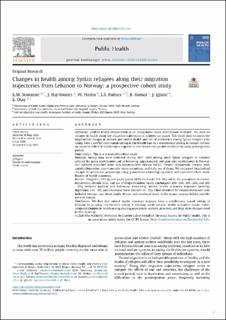| dc.description.abstract | Objectives: Conflict-driven displacement is an indisputable social determinant of health. Yet, data on changes in health along the migration trajectories of refugees are scarce. This study aims to assess the longitudinal changes in somatic and mental health and use of medication among Syrian refugees relocating from a conflict-near transit setting in the Middle East to a resettlement setting in Europe. Further, we examine different health status trajectories and factors that predict health in the early postmigration period.
Study design: This is a prospective cohort study.
Methods: Survey data were collected during 2017–2018 among adult Syrian refugees in Lebanon selected for quota resettlement and at follow-up approximately one year after resettlement in Norway. Our primary outcomes were non-communicable disease (NCD), chronic impairment, chronic pain, anxiety/depression, post-traumatic stress symptoms, and daily use of drugs. We estimated longitudinal changes in prevalence proportions using generalized estimating equations and evaluated effect modification of health outcomes.
Results: Altogether, 353 Syrians participated. NCDs declined (12%–9%), while the prevalence of chronic impairment, chronic pain, and use of drugs remained nearly unchanged (29%–28%, 30%–28%, and 20%–18%) between baseline and follow-up. Conversely, mental health outcomes improved (anxiety/depression 33%–11%, post-traumatic stress disorder 5%–2%). Effect modifiers for improvement over time included younger age, short length of stay, and non-legal status in the transit country before resettlement in Europe.
Conclusions: We find that mental health outcomes improve from a conflict-near transit setting in Lebanon to an early resettlement setting in Norway, while somatic health outcomes remain stable. Temporal changes in health among moving populations warrant attention, and long-term changes need further scrutiny. | en_US |

